horn TOYOTA CAMRY 2018 Owners Manual (in English)
[x] Cancel search | Manufacturer: TOYOTA, Model Year: 2018, Model line: CAMRY, Model: TOYOTA CAMRY 2018Pages: 612, PDF Size: 10.63 MB
Page 164 of 612
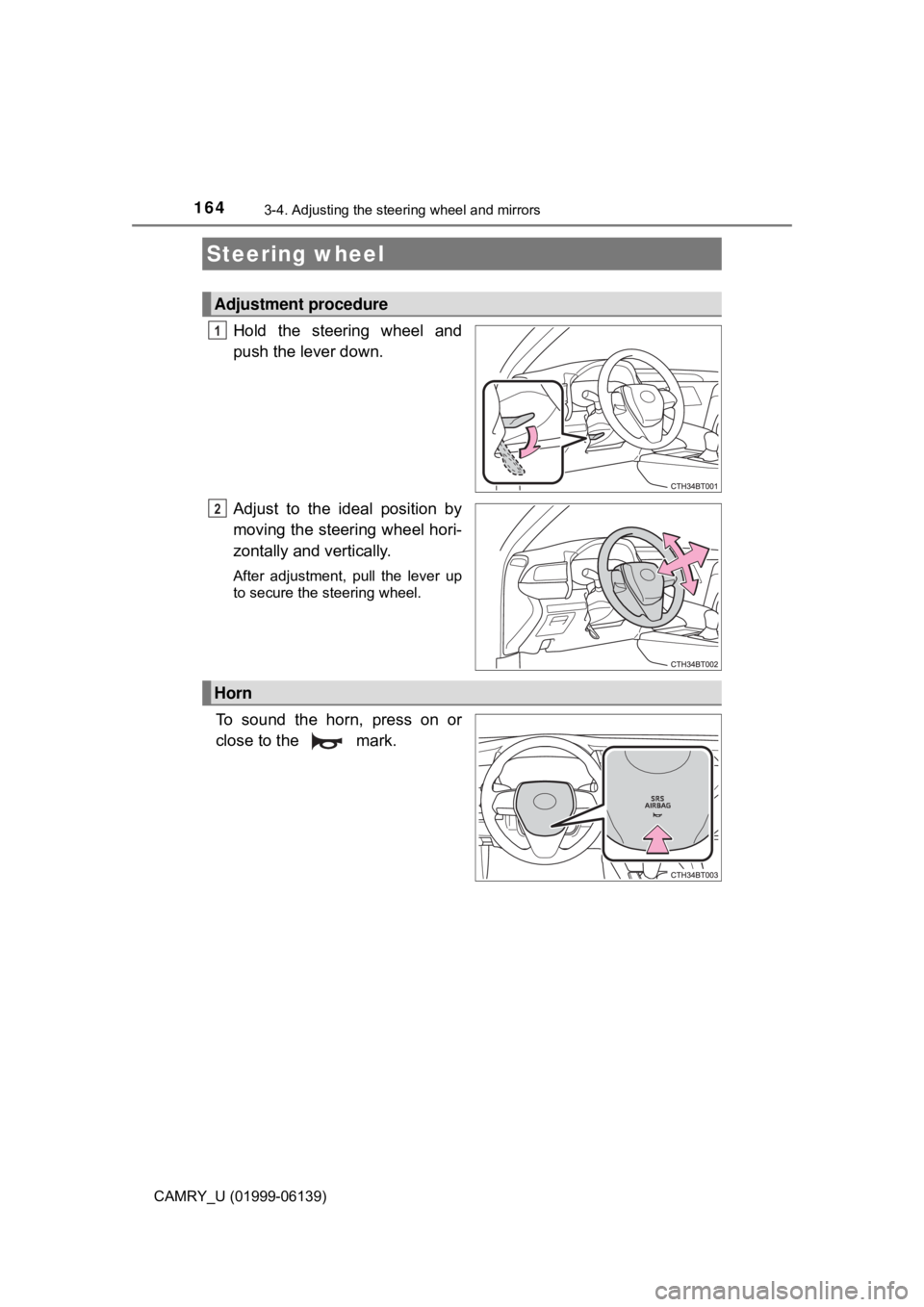
164
CAMRY_U (01999-06139)
3-4. Adjusting the steering wheel and mirrors
Hold the steering wheel and
push the lever down.
Adjust to the ideal position by
moving the steering wheel hori-
zontally and vertically.
After adjustment, pull the lever up
to secure the steering wheel.
To sound the horn, press on or
close to the mark.
Steering wheel
Adjustment procedure
1
2
Horn
Page 165 of 612

1653-4. Adjusting the steering wheel and mirrors
3
Operation of each component
CAMRY_U (01999-06139)
WARNING
■Caution while driving
Do not adjust the steering wheel while driving.
Doing so may cause the driver to mishandle the vehicle and cause an acci-
dent, resulting in death or serious injury.
■ After adjusting the steering wheel
Make sure that the steering wheel is securely locked.
Otherwise, the steering wheel may move suddenly, possibly causing an
accident, and resulting in death or serious injury. Also, the horn may not
sound if the steering wheel is not securely locked.
Page 320 of 612

3204-5. Using the driving support systems
CAMRY_U (01999-06139)
WARNING
■Sensors
Certain vehicle conditions and the surrounding environment may affect the
ability of a sensor to correctly detect an obstacle. Particular instances where
this may occur are listed below.
● There is dirt, snow or ice on the sensor. (Wiping the sensors will resolve
this problem.)
● The sensor is frozen. (Thawing the area will resolve this problem.)
In especially cold weather, if a sensor is frozen the screen may show an
abnormal display, or obstacles may not be detected.
● The sensor is covered in any way.
● The vehicle is leaning considerably to one side.
● On an extremely bumpy road, on an incline, on gravel, or on grass.
● The vicinity of the vehicle is noisy due to vehicle horns, motorcycle
engines, air brakes of large vehicles , or other loud noises producing ultra-
sonic waves.
● There is another vehicle equipped with parking assist sensors in the vicin-
ity.
● The sensor is coated with a sheet of spray or heavy rain.
● The sensor is drenched with water on a flooded road.
● The vehicle is equipped with a fender pole or wireless antenna.
● Towing eyelets are installed.
● The bumper or sensor receives a strong impact.
● The vehicle is approaching a tall or curved curb.
● The detection range is reduced due to an object such as a sign.
● In harsh sunlight or intense cold weather.
● The area directly under the bumpers is not detected.
● If obstacles draw too close to the sensor.
● A non-genuine Toyota suspension (lowered suspension, etc.) is installed.
● A backlit license plate is installed.
In addition to the examples above, there are instances in which, because of
their shape, signs and other objects may be judged by a sensor to be closer
than they are.
Page 331 of 612
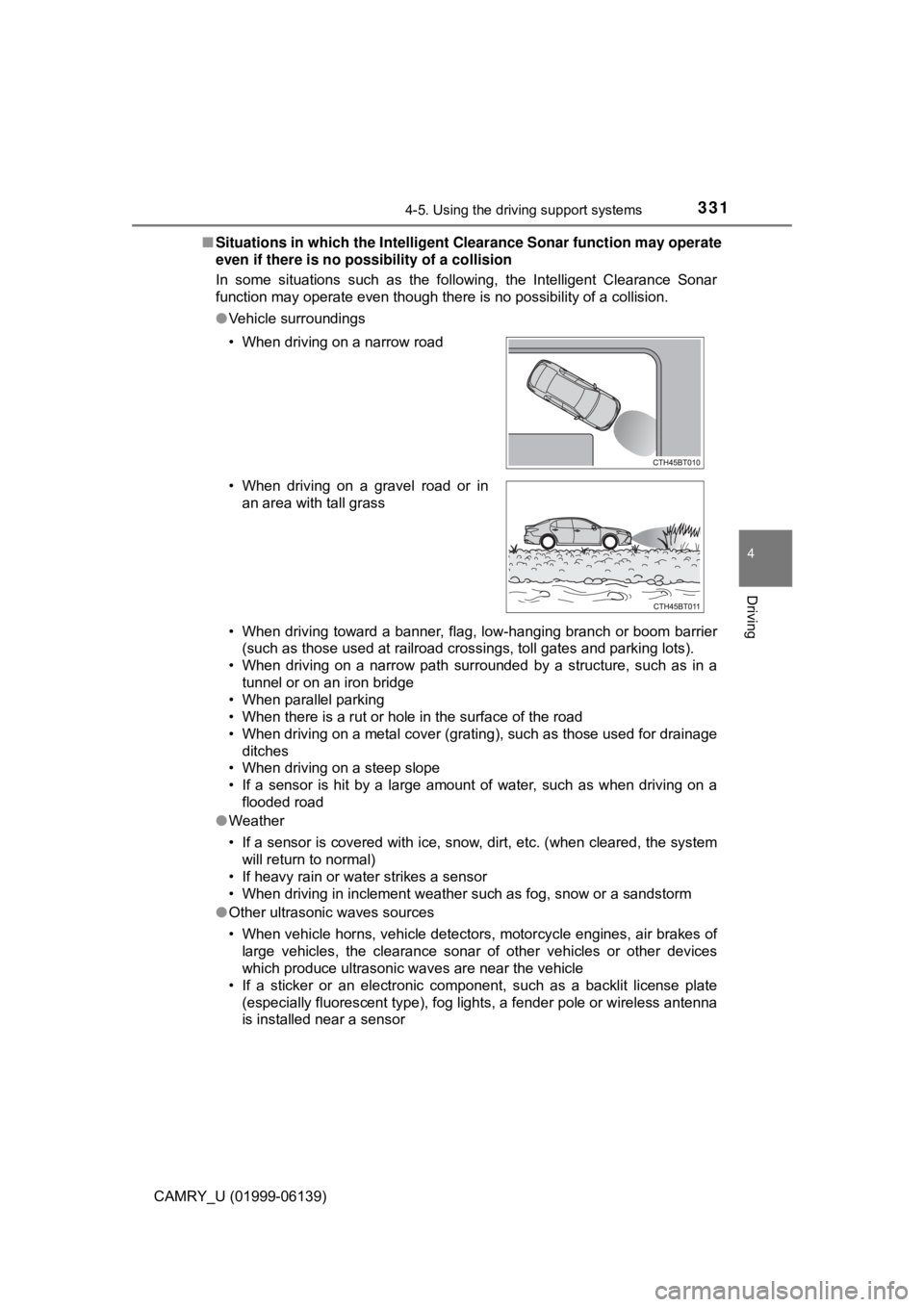
3314-5. Using the driving support systems
4
Driving
CAMRY_U (01999-06139)■
Situations in which the Intelligent Clearance Sona r function may operate
even if there is no possibility of a collision
In some situations such as the following, the Intelligent Clearance Sonar
function may operate even though there is no possibility of a collision.
● Vehicle surroundings
• When driving toward a banner, flag, low-hanging branch or boom barrier
(such as those used at railroad crossings, toll gates and parking lots).
• When driving on a narrow path surrounded by a structure, such as in a tunnel or on an iron bridge
• When parallel parking
• When there is a rut or hole in the surface of the road
• When driving on a metal cover (grating), such as those used for drainage
ditches
• When driving on a steep slope
• If a sensor is hit by a large amount of water, such as when driving on a
flooded road
● Weather
• If a sensor is covered with ice, snow, dirt, etc. (when cleared, the system
will return to normal)
• If heavy rain or water strikes a sensor
• When driving in inclement weather such as fog, snow or a sandstorm
● Other ultrasonic waves sources
• When vehicle horns, vehicle detectors, motorcycle engines, air brakes of
large vehicles, the clearance sonar of other vehicles or other devices
which produce ultrasonic waves are near the vehicle
• If a sticker or an electronic component, such as a backlit license plate
(especially fluorescent type), fog lights, a fender pole or wireless antenna
is installed near a sensor
• When driving on a narrow road
• When driving on a gravel road or in
an area with tall grass
Page 333 of 612

3334-5. Using the driving support systems
4
Driving
CAMRY_U (01999-06139)●
Other ultrasonic waves sources
• When vehicle horns, vehicle detectors, motorcycle engines, air brakes of
large vehicles, the clearance sonar of other vehicles or other devices
which produce ultrasonic waves are near the vehicle
• If a sticker or an electronic component, such as a backlit license plate (especially fluorescent type), fog lights, a fender pole or wireless antenna
is installed near a sensor
● Changes in the vehicle posture
• If the vehicle is significantly tilted
• If the front of the vehicle is raised or lowered due to the carried load
• If the orientation of a sensor has been changed due to a collision or other
impact
■ If a battery terminal has b een disconnected and reconnected
The system needs to be initialized.
To initialize the system, drive the vehicle straight ahead for 5 seconds or more
at a speed of approximately 22 mph (35 km/h) or more.
■ If “ICS Unavailable” is displayed on the multi-information display and
the ICS OFF indicator is flashing
● A sensor may be covered with ice, snow, dirt, etc. Remove the ice, snow,
dirt, etc., from the sensor to return the system to normal.
Also, due to ice forming on a sensor at low temperatures, a warning mes-
sage may be displayed or the sensor may not be able to detect an object.
Once the ice melts, the system will return to normal.
● If this message continues to be displayed even after cleaning the sensor, or
is displayed even though the sensor is clean, have the vehicle inspected by
your Toyota dealer.
● Initialization may not have been performed after a battery terminal was dis-
connected and reconnected. Initialize the system. ( →P. 333)
Page 524 of 612

5247-2. Steps to take in an emergency
CAMRY_U (01999-06139)
One of the following may be the cause of the problem:
●There may not be sufficient fuel in the vehicle’s tank.
Refuel the vehicle.
● The engine may be flooded.
Try to restart the engine again following correct starting procedures.
(→ P. 198, 200)
● There may be a malfunction in the engine immobilizer system.
(→ P. 71)
One of the following may be the cause of the problem:
● The battery may be discharged. ( →P. 529)
● The battery terminal connections may be loose or corroded.
The engine starting system may be malfunctioning due to an electrical
problem such as electronic key battery depletion or a blown fuse.
However, an interim measure is available to start the engine.
( → P. 525)
If the engine w ill not start
If the engine will not start eve n though correct starting proce-
dures are being followed ( →P. 198, 200), consider each of the fol-
lowing points:
The engine will not start even though the starter motor operates
normally.
The starter motor turns over slowly, the interior lights and head-
lights are dim, or the horn does not sound or sounds at a low
volume.
The starter motor does not turn over (vehicles with a smart key
system)
Page 525 of 612
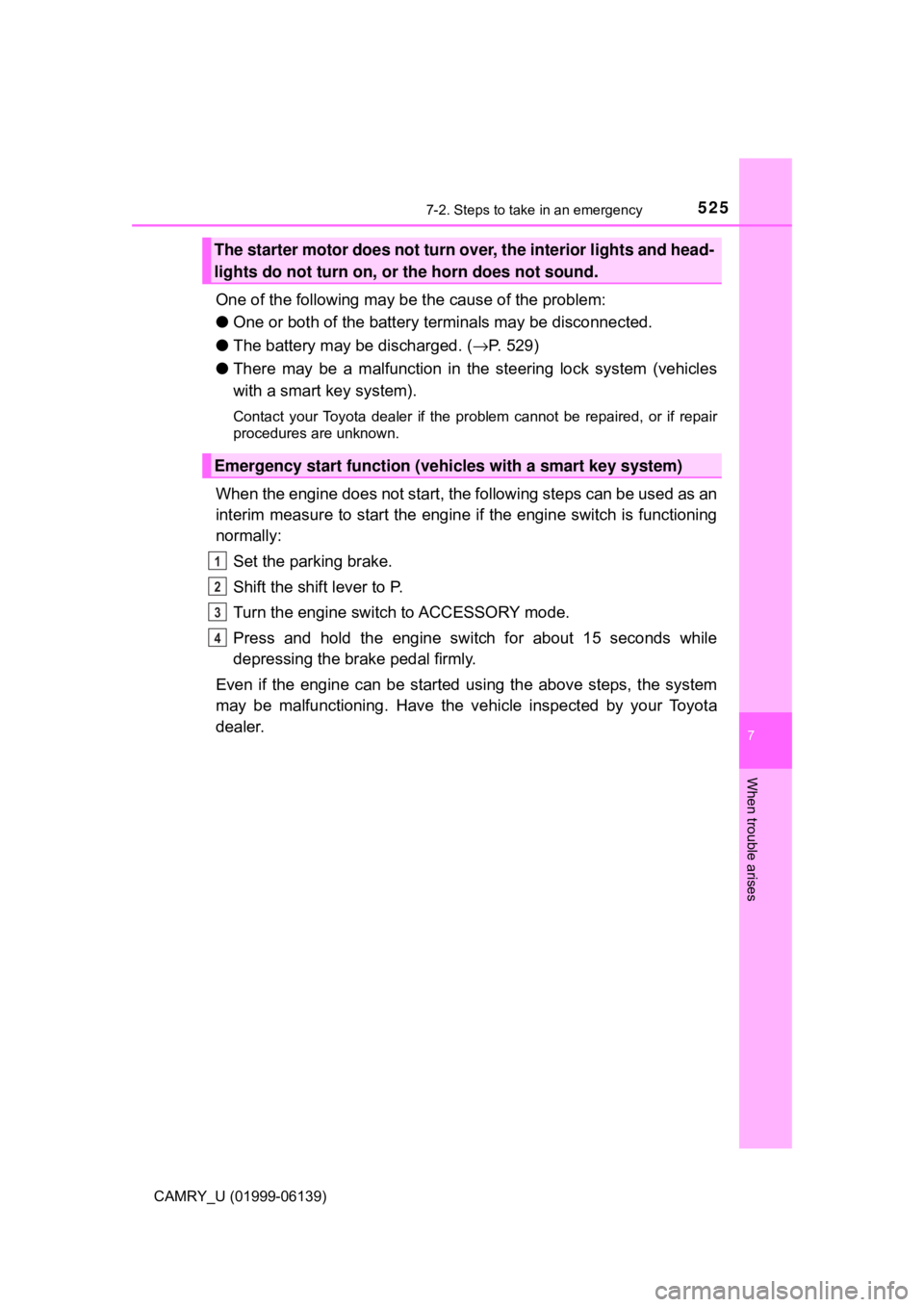
5257-2. Steps to take in an emergency
CAMRY_U (01999-06139)
7
When trouble arises
One of the following may be the cause of the problem:
●One or both of the battery terminals may be disconnected.
● The battery may be discharged. ( →P. 529)
● There may be a malfunction in the steering lock system (vehicles
with a smart key system).
Contact your Toyota dealer if the problem cannot be repaired, or if repair
procedures are unknown.
When the engine does not start, the following steps can be used as an
interim measure to start the engine if the engine switch is functioning
normally:
Set the parking brake.
Shift the shift lever to P.
Turn the engine switch to ACCESSORY mode.
Press and hold the engine switch for about 15 seconds while
depressing the brake pedal firmly.
Even if the engine can be started using the above steps, the system
may be malfunctioning. Have the ve hicle inspected by your Toyota
dealer.
The starter motor does not turn over, the interior lights and head-
lights do not turn on, or the horn does not sound.
Emergency start function (vehicles with a smart key system)
1
2
3
4
Page 595 of 612
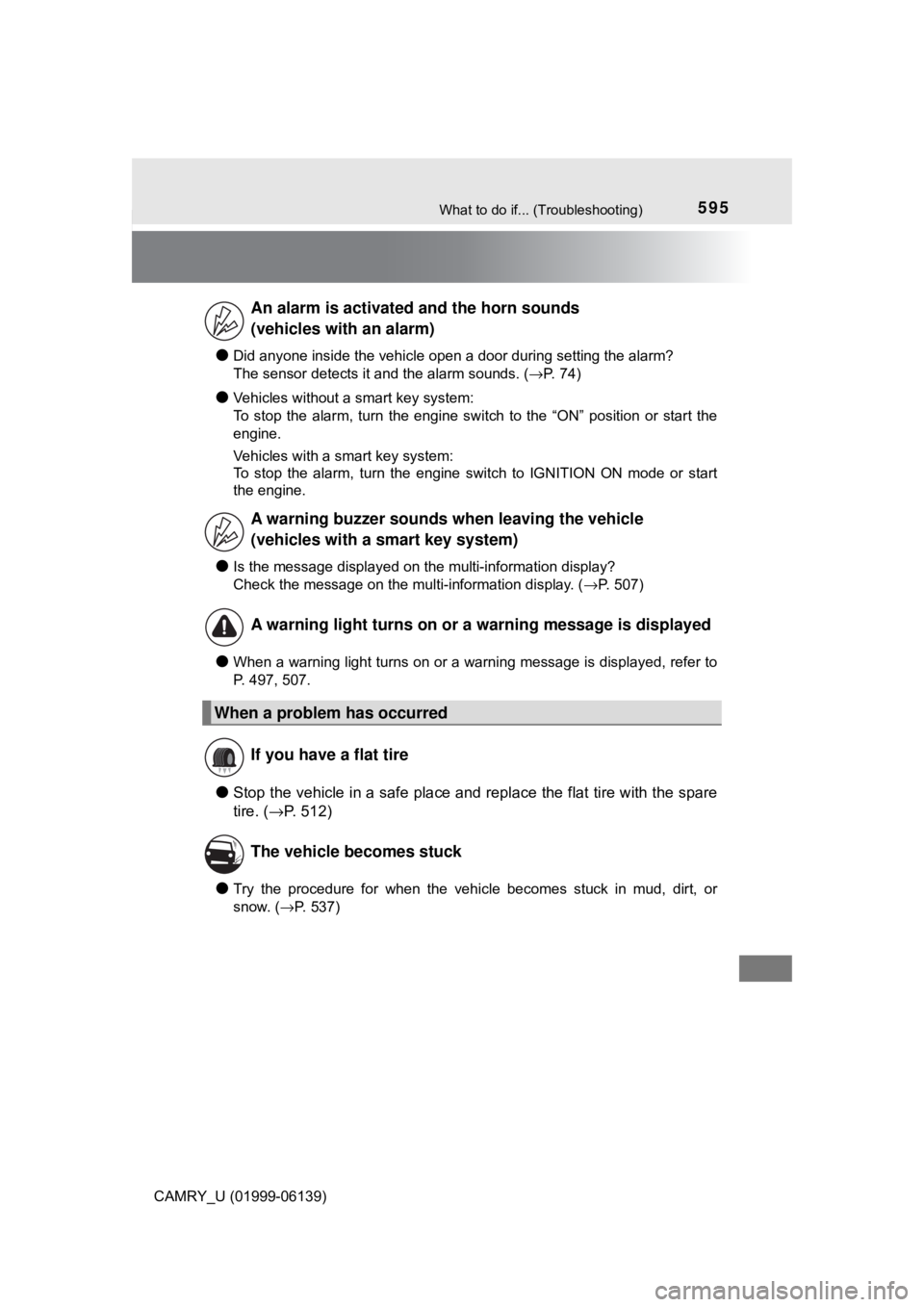
595What to do if... (Troubleshooting)
CAMRY_U (01999-06139)
●Did anyone inside the vehicle open a door during setting the alarm?
The sensor detects it and the alarm sounds. (→P. 74)
●Vehicles without a smart key system:
To stop the alarm, turn the engine switch to the “ON” position or start the
engine.
Vehicles with a smart key system:
To stop the alarm, turn the engine switch to IGNITION ON mode or start
the engine.
●Is the message displayed on the multi-information display?
Check the message on the multi-information display. ( →P. 507)
●When a warning light turns on or a warning message is displayed, refer to
P. 497, 507.
●Stop the vehicle in a safe place and replace the flat tire with the spare
tire. ( →P. 512)
●Try the procedure for when the vehicle becomes stuck in mud, dirt, or
snow. ( →P. 537)
An alarm is activated and the horn sounds
(vehicles with an alarm)
A warning buzzer sounds when leaving the vehicle
(vehicles with a smart key system)
A warning light turns on or a warning message is displayed
When a problem has occurred
If you have a flat tire
The vehicle becomes stuck
Page 601 of 612
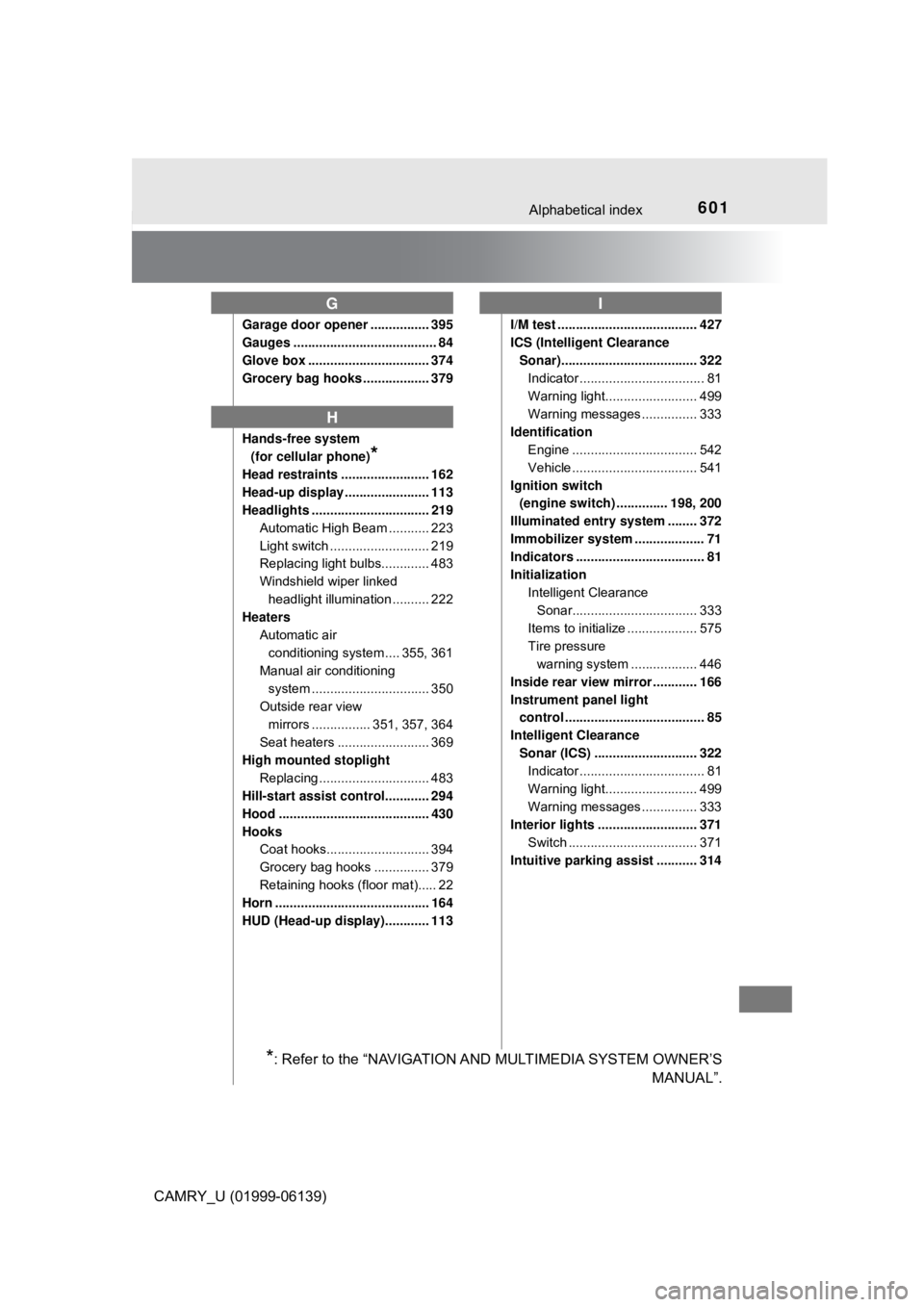
601Alphabetical index
CAMRY_U (01999-06139)
Garage door opener ................ 395
Gauges ....................................... 84
Glove box ................................. 374
Grocery bag hooks .................. 379
Hands-free system (for cellular phone)
*
Head restraints ........................ 162
Head-up display ....................... 113
Headlights ................................ 219
Automatic High Beam ........... 223
Light switch ........................... 219
Replacing light bulbs............. 483
Windshield wiper linked headlight illumination .......... 222
Heaters
Automatic air conditioning system .... 355, 361
Manual air conditioning
system ......... ....................... 350
Outside rear view mirrors ................ 351, 357, 364
Seat heaters ......................... 369
High mounted stoplight Replacing .............................. 483
Hill-start assist control............ 294
Hood ......................................... 430
Hooks Coat hooks............................ 394
Grocery bag hooks ............... 379
Retaining hooks (floor mat)..... 22
Horn .......................................... 164
HUD (Head-up display)............ 113 I/M test ...................................... 427
ICS (Intelligent Clearance
Sonar)..................................... 322 Indicator .................................. 81
Warning light......................... 499
Warning messages ............... 333
Identification Engine .................................. 542
Vehicle .................................. 541
Ignition switch (engine switch) .............. 198, 200
Illuminated entry system ........ 372
Immobilizer system ................... 71
Indicators ................................... 81
Initialization Intelligent Clearance Sonar.................................. 333
Items to initialize ................... 575
Tire pressure warning system .... .............. 446
Inside rear view mirror ............ 166
Instrument panel light control ...................................... 85
Intelligent Clearance Sonar (ICS) ............................ 322 Indicator .................................. 81
Warning light......................... 499
Warning messages ............... 333
Interior lights ........................... 371 Switch ................................... 371
Intuitive parking assist ........... 314
G
H
I
*: Refer to the “NAVIGATION AND MULTIMEDIA SYSTEM OWNER’S MANUAL”.